




Your support is critical to our success.

In habitat.
Origin and Habitat: Cycas confertaSN|29959]]SN|29959]] occurs in the Northern Territory of Australia. Populations are found from between Jim Jim Falls and Graveside Gorge in the Kakadu National Park, southwest through Goodparla and Mary River Station to Foelsche Headland, and north to Burrell Creek near Adelaide River. A large population of C. conferta has been reported near the headwaters of the Fergusson River, but as yet has not been confirmed. The distribution of this species is considered to be sporadic and local in occurrence, with plants forming isolated, usually small but dense, stands. The population estimates exceed 30,000 plants with a major concentration at Harriet Creek.
Habitat and Ecology: This species occurs in wooded hillsides on sandy soils over granites or coarse sandstones. In association with eucalyptus and grasses. Approximate rainfall is 1,000 mm per annum. Populations are found mainly on rocky outcrops and stunted woodland overlying Cullen granite and sandstone and quartz of the Brocks Creek Group. The soils are grey gravelly loams. Eucalyptus miniata is the dominant tree species in the woodland whereas the cycads are dominant on the outcrops. In the past, the large population at Harriet Creek has been extensively harvested for seed. Some of the smaller populations along the Kakadu Highway have been severely impacted by past removal of plants. However, because of the large numbers over a substantial area, the species is not presently at risk.
Synonyms:
- Cycas conferta Chirgwin
Description: Cycas confertaSN|28860]]SN|29959]] formerly known as cycas 'Pine Creek', is a slender, erect, arborescent cycad species mimicking the look of short palm trees that can grow up over 5 metres. Its leaves (fronds) are a beautiful sea blue-green on both surfaces, but a little more so above, inclined to be duller beneath, about 100 cm long (hence about 2 metres span) feathery and radiate from a central point at the top of a woody trunk-like stem and are distinguished by relatively long and usually unarmed petioles. The leaflets are broad, closely crowded, generally overlapping and often partly amphistomatic (having stomata on both surfaces). Newly developing leaf fronds are soft and flexible, whitish, palest blue, or fawn in colour and heavily orange tomentose on the back of young rachis, eventually glabrous as leaf expands.
Derivation of specifis name: From the Latin confertus, crowded, referring to the close crowding of the leaflets on the rachis.
Stems: Slender, solitary or branching and occasonally suckering, usually less than 4 m tall (the maximum observed being about 7 m), 9-13 cm diameter at narrowest point.
Leaves: Blue-green on both surfaces but a little more so above and inclined to be duller beneath, 70-110 cm long, slightly keeled to flat in section. Pinnae (leaflets) opposite and alternate, generally overlapping, specially in the top two-thirds of fronds with light brown tomentum on crown of the plants. Opposing leaflets inserted at 130-180° on rachis, with 160-240 leaflets. Pinnae size, middle ones 70-120 mm long, 6-8 mm wide, 5-8 mm apart on rachis, section flat; margins flat; top ones about 36 mm long, basal 30 mm long, decument in almost all cases with the mid rib sunken above. Basal leaflets not gradually reducing to spines. Newly produced leaflets with white and orange tomentum shedding as leaf expands. Rachis consistently terminated by a spine (sometimes toothed). Petiole 20-45 cm long, glabrous (or loosely pubescent), unarmed (or with soft spines to 24 pairs on the petiole of a mature rachis).
Cataphylls: The cataphylls (Modified leaf, much reduced and thickened, serving to protect the apical meristem in cycads produced in flushes preceding the emergence of cones or leaves.) are linear, pungent, pilose, 60-90 mm long and persistent.
Megasporophyll: Like other Cycas species, the female plants do not bear cones; instead they carry ovules and seeds on 30 to 40 megasporophylls to a crown. These are 17-22 cm long, grey-tomentose and brown-tomentose. Lamina lanceolate, 45-75 mm long, 18-30 mm wide, regularly dentate, with 18-24 pungent lateral spines 1-3 mm long, 1 mm wide, apical spine distinct from lateral spines, 8 mm long, 2-4 mm wide at base. Ovules per megasporophyl 2-4(-6), glabrous.
Male cones: Ovoid, orange, 11-18 cm in height and about 8.5 mm in diameter; peduncle height 30 mm x 170 mm. Microsporophyll lamina firm, not dorsiventrally thickened, 25-29 mm long, 14-17 mm wide, fertile zone 19-24 mm long, sterile apex 5-9 mm long, level, apical spine prominent, sharply upturned, 7-11 mm long.
Seeds: Flattened-ovoid to oblong or pear-shape, 40 mm long, 30 mm wide; sarcotesta turning brownish-purple when mature, slightly pruinose, 2-3 mm thick; fibrous layer absent; sclerotesta smooth. Spongy endocarp absent.
Similar species: Cycas armstrongii has been confused with this species, but differs in the shorter, more frequently spinescent petioles and the glossy, d more widely spaced leaflets. The habit of C. armstrongii is also smaller. Cycas papuanaSN|29959]]SN|28860]] from the Western District of Papua New Guinea shares the long petioles and crowded, concolorous leaflets, but has more robust male cones with elongated, decurved sterile apices on the male sporophylls.
Bibliography: Major references and further lectures
1) Ottley, H. 2010. Cycas conferta. The IUCN Red List of Threatened Species. Version 2015.2. <www.iucnredlist.org>. Downloaded on 30 August 2015.
2) Boris Lariushin “Cycadaceae Family” Lulu.com
3) Whitelock, Loran M., “The Cycads”, Timber press, 2002.
4) Haynes J.L, “World List of Cycads: A Historical Review”, IUCN/SSC Cycad Specialist Group, 2012
5) V.P. Singh “Gymnosperm (naked seeds plant) : structure and development” Sarup & Sons, 01 january 2006
6) Australian Plants, Volume 18, Edizione 141 page 67, Society for Growing Australian Plants., 1994
7) The Cycad Pages “Cycas conferta” Royal Botanic Gardens Sydney Written and maintained by Ken Hill 1998-2010 Maintained by Leonie Stanberg and Dennis Stevenson 2010-2012 <http://plantnet.rbgsyd.nsw.gov.au/cgi-bin/cycadpg?taxname=Cycas+conferta> Web. 25 August 2015
8) PACSOA contributors “Cycas conferta”. In: Cycads. Palm and Cycad Societies of Australia (PACSOA). 23 November 2013 Web. 28 August 2015.

In habitat Photo by: Josef Cycad Perner
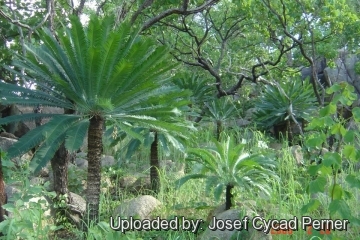
Cycas conferta Photo by: Josef Cycad Perner
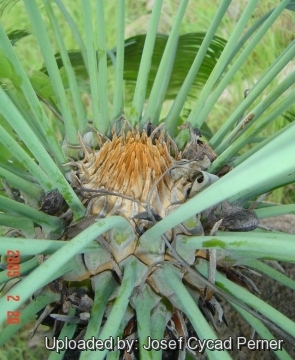
Cataphylls. Photo by: Josef Cycad Perner
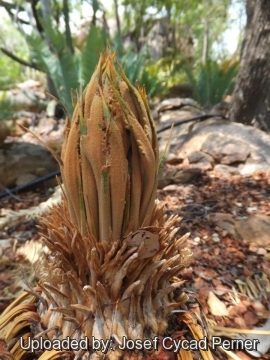
Cycad Cones in Joe's Cycad Gardens. Cycas conferta, Female cone, this is the first time for this plant to show sex. Photo by: Josef Cycad Perner

In the dry season Cycas conferta is deciduous, leaves will die and fall off, this plant is now beginning to flush new leaves. Photo by: Josef Cycad Perner

Cycas conferta Photo by: Josef Cycad Perner
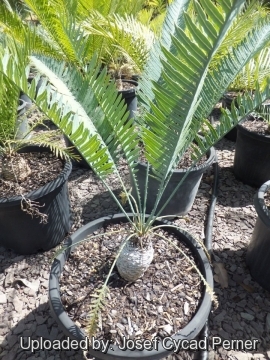
Old specimen grown from seed. At Cycad International. Katherine (Australia) Photo by: Josef Cycad Perner
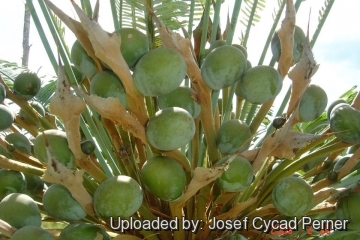
Unripe seeds. Photo by: Josef Cycad Perner
Cultivation and Propagation: Cycas confertaSN|29959]]SN|29959]] is suited to tropical regions which have a seasonally dry climate. It is easy to grow, tolerating dry periods, but up to the time of this writing this species is not common in cultivation.
Growth rate: Usually slow growing, however good conditions can speed it up considerably. Because of its growth habit, fertilize only when terminal bud begins to swell, indicating the start of the annual growth cycle.
Exposure: It prefers bright light exposure but colour bleaches when in full sun; best with some protection from afternoon heat.
Soil: Needs a well drained spot, with deep soil, but will still thrive in less than ideal conditions.
Maintenance: Minimal; removal of offsets if desired, removal of spent fronds.
Use: Landscape as cultivated perennial in warm, coastal areas; House-plant or interior-scape, as container plant in cool areas, as well very well suited to bonsai culture.
Propagation: Seed or offshoots (or "pups"). The advantage of the "pups" is that you will know its sex, for seedlings you will have to wait several years until the plant flowers to find out. After fertile seeds are collected, they usually need several months of storage before the inner embryo is ready to germinate. Therefore, it is best to clean the seeds of external fruit and set them aside before attempting to propagate the seeds.
| Your Actions | |
|---|---|
| Back to Cycas index | |
| Back to Cycadaceae index | |
 |
Back to Palms And Cycads Encyclopedia index |
Privacy stantement - Terms and conditions - How to cite - About us - Feedback - Donate





